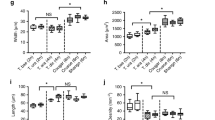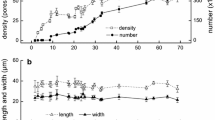Abstract
Main conclusion
This study suggests that stomatal and leaf structures are highly correlated, and mesophyll cell size is an important anatomical trait determining the coordination between stomatal size and mesophyll porosity.
Abstract
A comprehensive study of the correlations between the structural traits and on their relationships with gas exchange parameters may provide some useful information into leaf development and improvement in efficiencies of photosynthetic CO2 fixation and transpirational water loss. In the present study, nine plant materials from eight crop species were pot grown in a growth chamber. Leaf structural traits, gas exchange, and leaf nitrogen content were measured. We found that stomatal size, mesophyll cell size (MCS), and mesophyll porosity were positively correlated and that the surface areas of mesophyll cells and chloroplasts facing intercellular air spaces were positively correlated with both stomatal density and stomatal area per leaf area (SA). These results suggested that the developments of stomata and mesophyll cells are highly correlated among different crop species. Additionally, MCS was positively correlated with leaf thickness and negatively correlated with leaf density and leaf mass per area, which indicated that MCS might play an important role in leaf structural investments and physiological functions among species. In summary, this study illustrates the correlations between stomatal and mesophyll structures, and it highlights the importance of considering the covariations among leaf traits with the intent of improving photosynthesis and iWUE.









Similar content being viewed by others
Data availability
All data generated or analyzed during this study are included in this published article (and its supplementary information files).
References
Baillie AL, Fleming AJ (2020) The developmental relationship between stomata and mesophyll airspace. New Phytol 225:1120–1126
Beaulieu JM, Leitch IJ, Patel S, Pendharkar A, Knight CA (2008) Genome size is a strong predictor of cell size and stomatal density in angiosperms. New Phytol 179:975–986
Brodribb TJ, Jordan GJ, Carpenter RJ (2013) Unified changes in cell size permit coordinated leaf evolution. New Phytol 199:559–570
Buckley TN (2015) The contributions of apoplastic, symplastic and gas phase pathways for water transport outside the bundle sheath in leaves. Plant Cell Environ 38:7–22
Buckley TN, John GP, Scoffoni C, Sack L (2015) How does leaf anatomy influence water transport outside the xylem? Plant Physiol 168:1616–1635
Caine RS, Yin X, Sloan J et al (2019) Rice with reduced stomatal density conserves water and has improved drought tolerance under future climate conditions. New Phytol 221:371–384
Dow GJ, Berry JA, Bergmann DC (2017) Disruption of stomatal lineage signaling or transcriptional regulators has differential effects on mesophyll development, but maintains coordination of gas exchange. New Phytol 216:69–75
Dunn J, Hunt L, Afsharinafar M et al (2019) Reduced stomatal density in bread wheat leads to increased water-use efficiency. J Exp Bot 70:4737–4748
Ethier GJ, Livingston NJ (2004) On the need to incorporate sensitivity to CO2 transfer conductance into the Farquhar–von Caemmerer-Berry leaf photosynthesis model. Plant Cell Environ 27:137–153
Evans JR (1983) Nitrogen and photosynthesis in the flag leaf of wheat (Triticum aestivum L.). Plant Physiol 72:297–302
Evans JR (1989) Photosynthesis and nitrogen relationships in leaves of C3 plants. Oecologia 78:9–19
Evans JR, Seemann JR (1989) The allocation of protein nitrogen in the photosynthetic apparatus: costs, consequences, and control. Photosynthesis 8:183–205
Evans JR, Caemmerer SV, Setchell BA, Hudson GS (1994) The relationship between CO2 transfer conductance and leaf anatomy in transgenic tobacco with a reduced content of Rubisco. Funct Plant Biol 21:475–495
Evans JR, Kaldenhoff R, Genty B, Terashima I (2009) Resistances along the CO2 diffusion pathway inside leaves. J Exp Bot 60:2235–2248
Farquhar GD, Raschke K (1978) On the resistance to transpiration of the sites of evaporation within the leaf. Plant Physiol 61:1000–1005
Farquhar GD, von Caemmerer S, Berry JA (1980) A biochemical model of photosynthetic CO2 assimilation in leaves of C3 species. Planta 149:78–90
Flexas J (2016) Genetic improvement of leaf photosynthesis and intrinsic water use efficiency in C3 plants: why so much little success? Plant Sci 251:155–161
Flexas J, Ribas-Carbo M, Diaz-Espejo A, Galmes J, Medrano H (2008) Mesophyll conductance to CO2: current knowledge and future prospects. Plant Cell Environ 31:602–621
Flexas J, Niinemets Ü, Gallé A et al (2013) Diffusional conductances to CO2 as a target for increasing photosynthesis and photosynthetic water-use efficiency. Photosynth Res 117:45–59
Franks PJ, Doheny-Adams TW, Britton-Harper ZJ, Gray JE (2015) Increasing water-use efficiency directly through genetic manipulation of stomatal density. New Phytol 207:188–195
Gago J, Douthe C, Florez-Sarasa I et al (2014) Opportunities for improving leaf water use efficiency under climate change conditions. Plant Sci 226:108–119
Giuliani R, Koteyeva N, Voznesenskaya E, Evans MA, Cousins AB, Edwards GE (2013) Coordination of leaf photosynthesis, transpiration, and structural traits in rice and wild relatives (genus Oryza). Plant Physiol 162:1632–1651
Harley PC, Loreto F, Di Marco G, Sharkey TD (1992) Theoretical considerations when estimating the mesophyll conductance to CO2 flux by analysis of the response of photosynthesis to CO2. Plant Physiol 98:1429–1436
Hikosaka K, Terashima I (1996) Nitrogen partitioning among photosynthetic components and its consequence in sun and shade plants. Funct Ecol 335–343
John GP, Scoffoni C, Sack L (2013) Allometry of cells and tissues within leaves. Am J Bot 100:1936–1948
Kaiser HF (1960) The application of electronic computers to factor analysis. Educ Psychol Meas 20:141–151
Kitajima K, Llorens AM, Stefanescu C, Timchenko MV, Lucas PW, Wright SJ (2012) How cellulose-based leaf toughness and lamina density contribute to long leaf lifespans of shade-tolerant species. New Phytol 195:640–652
Lehmeier C, Pajor R, Lundgren MR et al (2017) Cell density and airspace patterning in the leaf can be manipulated to increase leaf photosynthetic capacity. Plant J 92:981–994
Li Y, Ren B, Yang X, Xu G, Shen Q, Guo S (2012) Chloroplast downsizing under nitrate nutrition restrained mesophyll conductance and photosynthesis in rice (Oryza sativa L.) under drought conditions. Plant Cell Physiol 53:892–900
Lu Z, Xie K, Pan Y et al (2019) Potassium mediates coordination of leaf photosynthesis and hydraulic conductance by modifications of leaf anatomy. Plant Cell Environ 42:2231–2244
Lundgren MR, Fleming AJ (2020) Cellular perspectives for improving mesophyll conductance. Plant J 101:845–857
Lundgren MR, Mathers A, Baillie AL et al (2019) Mesophyll porosity is modulated by the presence of functional stomata. Nat Commun 10:1–10
Makino A (2003) Rubisco and nitrogen relationships in rice: leaf photosynthesis and plant growth. Soil Sci Plant Nutr 49:319–327
Makino A, Osmond B (1991) Effects of nitrogen nutrition on nitrogen partitioning between chloroplasts and mitochondria in pea and wheat. Plant Physiol 96:355–362
Makino A, Mae T, Ohira K (1984) Relation between nitrogen and ribulose-1, 5-bisphosphate carboxylase in rice leaves from emergence through senescence. Plant Cell Physiol 25:429–437
Merino J, Field C, Mooney HA (1984) Construction and maintenance costs of Mediterranean-climate evergreen and deciduous leaves. II: biochemical pathway analysis. Acta Oecol (montrouge) 5:211–229
Onoda Y, Wright IJ, Evans JR et al (2017) Physiological and structural tradeoffs underlying the leaf economics spectrum. New Phytol 214:1447–1463
Ouyang W, Struik PC, Yin X, Yang J (2017) Stomatal conductance, mesophyll conductance, and transpiration efficiency in relation to leaf anatomy in rice and wheat genotypes under drought. J Exp Bot 68:5191–5205
Pathare VS, Koteyeva N, Cousins AB (2020) Increased adaxial stomatal density is associated with greater mesophyll surface area exposed to intercellular air spaces and mesophyll conductance in diverse C4 grasses. New Phytol 225:169–182
Poorter H, Niinemets Ü, Poorter L, Wright IJ, Villar R (2009) Causes and consequences of variation in leaf mass per area (LMA): a meta-analysis. New Phytol 182:565–588
Read J, Sanson GD (2003) Characterizing sclerophylly: the mechanical properties of a diverse range of leaf types. New Phytol 160:81–99
Reich PB, Walters MB, Ellsworth DS (1997) From tropics to tundra: global convergence in plant functioning. Proc Natl Acad Sci USA 94:13730–13734
Sharkey TD, Bernacchi CJ, Farquhar GD, Singsaas EL (2007) Fitting photosynthetic carbon dioxide response curves for C3 leaves. Plant Cell Environ 30:1035–1040
Shipley B, Lechowicz MJ, Wright I, Reich PB (2006) Fundamental trade-offs generating the worldwide leaf economics spectrum. Ecology 87:535–541
Terashima I, Miyazawa SI, Hanba YT (2001) Why are sun leaves thicker than shade leaves?—Consideration based on analyses of CO2 diffusion in the leaf. J Plant Res 114:93–105
Terashima I, Hanba YT, Tazoe Y, Vyas P, Yano S (2006) Irradiance and phenotype: comparative eco-development of sun and shade leaves in relation to photosynthetic CO2 diffusion. J Exp Bot 57:343–354
Terashima I, Hanba YT, Tholen D, Niinemets Ü (2011) Leaf functional anatomy in relation to photosynthesis. Plant Physiol 155:108–116
Théroux-Rancourt G, Éthier G, Pepin S (2015) Greater efficiency of water use in poplar clones having a delayed response of mesophyll conductance to drought. Tree Physiol 35:172–184
Théroux-Rancourt G, Roddy AB, Earles JM et al (2021) Maximum CO2 diffusion inside leaves is limited by the scaling of cell size and genome size. Proc Biol Sci 288:20203145
Tomás M, Flexas J, Copolovici L et al (2013) Importance of leaf anatomy in determining mesophyll diffusion conductance to CO2 across species: quantitative limitations and scaling up by models. J Exp Bot 64:2269–2281
Tosens T, Niinemets Ü, Westoby M, Wright IJ (2012a) Anatomical basis of variation in mesophyll resistance in eastern Australian sclerophylls: news of a long and winding path. J Exp Bot 63:5105–5119
Tosens T, Niinemets U, Vislap V, Eichelmann H, Castro Diez P (2012b) Developmental changes in mesophyll diffusion conductance and photosynthetic capacity under different light and water availabilities in Populus tremula: how structure constrains function. Plant Cell Environ 35:839–856
Valentini R, Epron D, De Angelis P, Matteucci G, Dreyer E (1995) In situ estimation of net CO2 assimilation, photosynthetic electron flow and photorespiration in Turkey oak (Q. cerris L.) leaves: diurnal cycles under different levels of water supply. Plant Cell Environ 18:631–640
Wright IJ, Reich PB, Westoby M et al (2004) The worldwide leaf economics spectrum. Nature 428:821–827
Xiong D, Flexas J (2018) Leaf economics spectrum in rice: leaf anatomical, biochemical, and physiological trait trade-offs. J Exp Bot 69:5599–5609
Xiong D, Liu XI, Liu L, Douthe C, Li Y, Peng S, Huang J (2015) Rapid responses of mesophyll conductance to changes of CO2 concentration, temperature and irradiance are affected by N supplements in rice. Plant Cell Environ 38:2541–2550
Xiong D, Flexas J, Yu T, Peng S, Huang J (2017) Leaf anatomy mediates coordination of leaf hydraulic conductance and mesophyll conductance to CO2 in Oryza. New Phytol 213:572–583
Acknowledgements
This research was supported by the National Natural Science Foundation of China (32172103) and the Fundamental Research Funds for the Central Universities (2021ZKPY017).
Funding
National Natural Science Foundation of China, 32172103, Yong Li, Fundamental Research Funds for the Central Universities, 2021ZKPY017, Yong Li.
Author information
Authors and Affiliations
Contributions
Y.L. and G.H. conceived and designed the research. G.H., Y.Y., and L.Z. conducted the experiments and collected the data. Y.L. and G.H. analyzed the data and wrote the paper. X.R. and S.P. commented and revised the paper.
Corresponding author
Additional information
Communicated by Dorothea Bartels.
Publisher's Note
Springer Nature remains neutral with regard to jurisdictional claims in published maps and institutional affiliations.
Supplementary Information
Below is the link to the electronic supplementary material.
Rights and permissions
About this article
Cite this article
Huang, G., Yang, Y., Zhu, L. et al. The structural correlations and the physiological functions of stomatal morphology and leaf structures in C3 annual crops. Planta 256, 39 (2022). https://doi.org/10.1007/s00425-022-03956-6
Received:
Accepted:
Published:
DOI: https://doi.org/10.1007/s00425-022-03956-6




